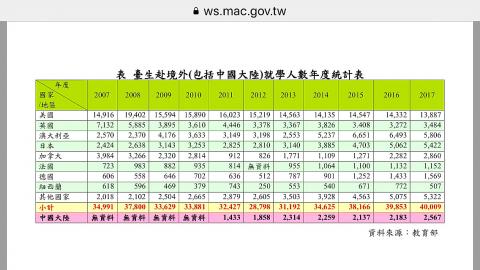The number of Taiwanese senior-high school graduates pursuing further studies abroad increased by more than 20 percent from about 32,000 people in 2011 to more than 40,000 people in 2017, the latest data from the Ministry of Education showed.
Due to the nation’s declining birthrate, the number of senior-high school graduates dropped from about 400,000 people in 2011 to 350,000 people in 2017 and further down to about 330,000 people last year, the data showed.
The number of senior-high school graduates pursuing higher education in China increased from 1,433 people in 2011 to 2,567 people in 2017, rising by about 80 percent, but accounting for less than 6 percent of the total number of those studying abroad, which shows that China does not attract Taiwanese students as much as English-speaking countries do.

Photo copied by Lin Hsiao-yun, Taipei Times
However, the increasing number of high-school graduates studying abroad poses a threat to the nation’s higher education system.
While Taiwanese universities still have a competitive advantage, the ministry this year is to grant an additional NT$1.3 billion (US$42.09 million) to 10 universities, including National Taiwan University, National Cheng Kung University, National Tsing Hua University and National Chiao Tung University, to enhance their international competitiveness, Department of Higher Education Director-General Chu Chun-chang (朱俊彰) said.
Ministry data showed that among the more than 30,000 senior-high school graduates studying abroad every year, the US was the most favored destination, followed by Japan, Australia and the UK.
In 2017, among the 40,009 senior-high school graduates who went on to study overseas, 13,887 people chose the US; 5,806 people picked Australia; 5,422 people went to Japan; and 2,567 people selected China, similar to the number that went to Canada, 2,860 people, the data showed.
The data also showed that among the list of senior-high schools whose students went on to study abroad after graduating in 2017, six of the top 10 schools were private schools.
Despite the media hype that Taiwanese students are increasingly choosing China for further studies, the data showed that a majority are still opting for the US or European nations, Chu said.
Boosting the competitive advantages of Taiwanese universities is the best way to keep senior-high school graduates in Taiwan, Chu said, adding that according to the Global Competitiveness Report 2017–2018 published by the World Economic Forum, Taiwan’s higher education and training ranked 17th in the world, while China only ranked 47th.
Aside from the additional subsidy to bolster universities’ competitiveness, the ministry is also cooperating with universities to offer international student exchanges, short-term programs, conferences and internship opportunities to attract foreign students and researchers to facilitate exchanges with students and teachers in Taiwan.
Taiwanese universities still offer students a chance to cultivate a global perspective and a promising future, Chu said.
Students opting to go to China should be aware of the risks that the Mainland Affairs Council has mentioned, because while Taiwan’s education environment allows freedom of speech and unlimited research topics, students in China have limited freedom of speech and expression in class or on the Internet, he said.

Taiwan is to commence mass production of the Tien Kung (天弓, “Sky Bow”) III, IV and V missiles by the second quarter of this year if the legislature approves the government’s NT$1.25 trillion (US$39.78 billion) special defense budget, an official said yesterday. Commenting on condition of anonymity, a defense official with knowledge of the matter said that the advanced systems are expected to provide crucial capabilities against ballistic and cruise missiles for the proposed “T-Dome,” an advanced, multi-layered air defense network. The Tien Kung III is an air defense missile with a maximum interception altitude of 35km. The Tien Kung IV and V

The disruption of 941 flights in and out of Taiwan due to China’s large-scale military exercises was no accident, but rather the result of a “quasi-blockade” used to simulate creating the air and sea routes needed for an amphibious landing, a military expert said. The disruptions occurred on Tuesday and lasted about 10 hours as China conducted live-fire drills in the Taiwan Strait. The Civil Aviation Administration (CAA) said the exercises affected 857 international flights and 84 domestic flights, affecting more than 100,000 travelers. Su Tzu-yun (蘇紫雲), a research fellow at the government-sponsored Institute for National Defense and Security Research, said the air

Trips for more than 100,000 international and domestic air travelers could be disrupted as China launches a military exercise around Taiwan today, Taiwan’s Civil Aviation Administration (CAA) said yesterday. The exercise could affect nearly 900 flights scheduled to enter the Taipei Flight Information Region (FIR) during the exercise window, it added. A notice issued by the Chinese Civil Aviation Administration showed there would be seven temporary zones around the Taiwan Strait which would be used for live-fire exercises, lasting from 8am to 6pm today. All aircraft are prohibited from entering during exercise, it says. Taipei FIR has 14 international air routes and

Taiwan lacks effective and cost-efficient armaments to intercept rockets, making the planned “T-Dome” interception system necessary, two experts said on Tuesday. The concerns were raised after China’s military fired two waves of rockets during live-fire drills around Taiwan on Tuesday, part of two-day exercises code-named “Justice Mission 2025.” The first wave involved 17 rockets launched at 9am from Pingtan in China’s Fujian Province, according to Lieutenant General Hsieh Jih-sheng (謝日升) of the Office of the Deputy Chief of the General Staff for Intelligence at the Ministry of National Defense. Those rockets landed 70 nautical miles (129.6km) northeast of Keelung without flying over Taiwan,